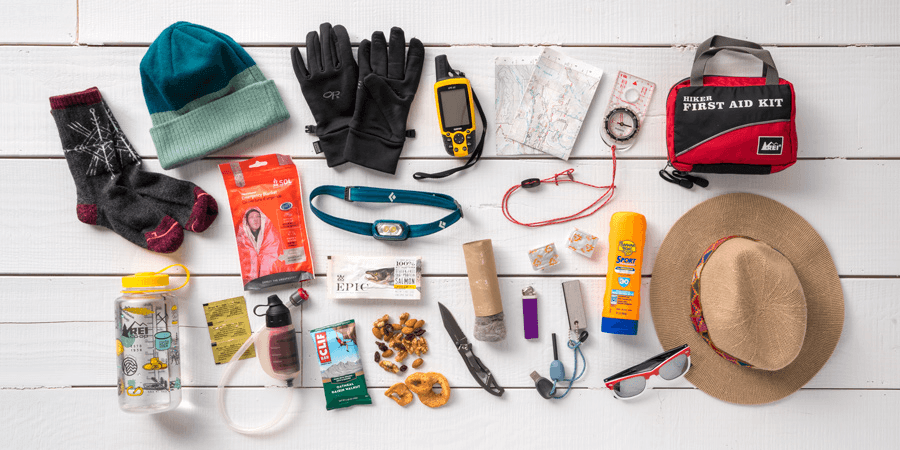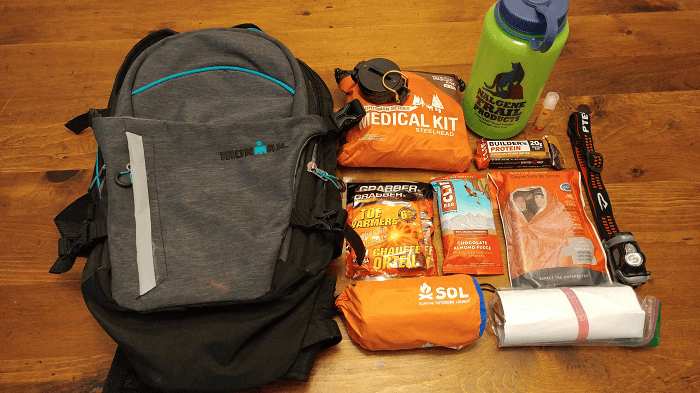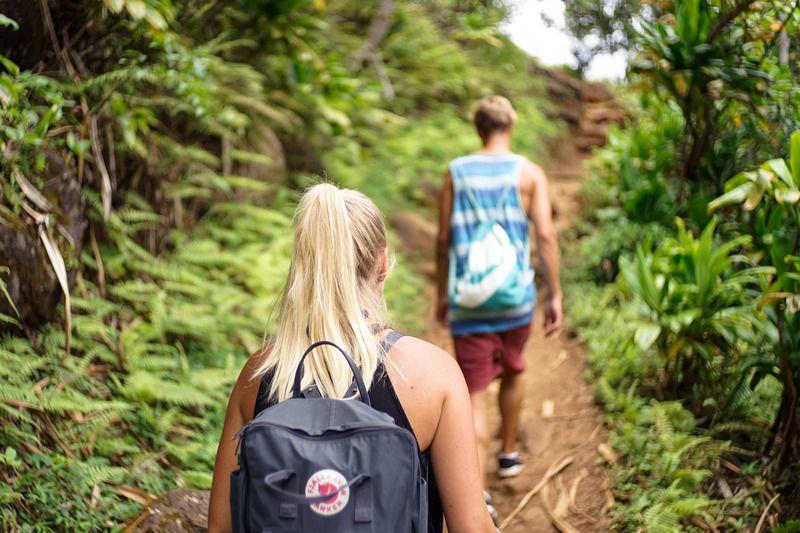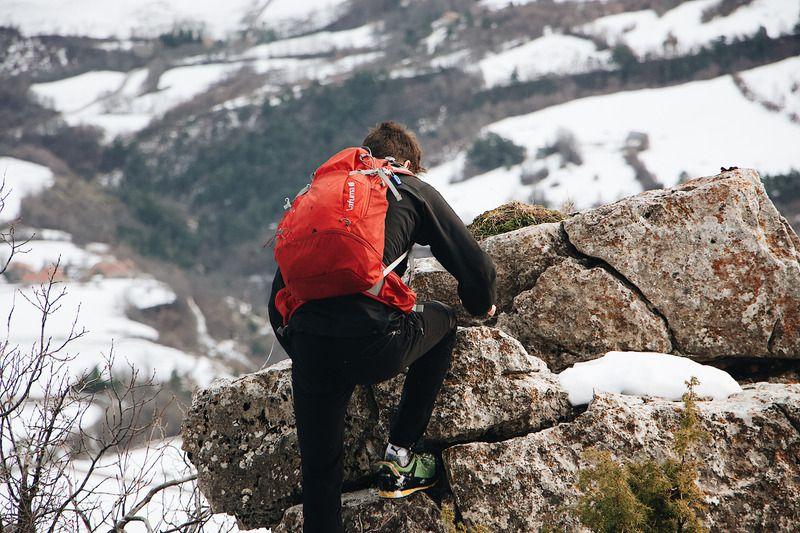Contents
Introduction To What to Bring on a Hike
Hiking, it’s a great exercise and also an excellent pastime for millions of people. It helps you train yourself in the art of perseverance in the woods. The result is a healthy mind and body. To enjoy climbing, you need to be prepared. Unprepared climbing is an invitation to disaster; thus, it’s best to know what to bring on a hike.
Whether you’re walking to your favorite waterfall or participating in a challenging peak, it’s crucial to wear the right equipment. When things go wrong, it can usually mean the difference between a minor discomfort and a frightening outcome. For avid travelers and wise in landers, calling mountain equipment on essential days is an essential part of preparation before any trip.
In the article below, we will talk about our opinions and preferences on what to bring on a hike, which is essential during the day and night.

Clothing
- Unique clothing is necessary when climbing, as they can be colder or stormier in the mountains than in the city. Likewise, if you get lost or injured, it is good to go out at night in the mountains in search of clothes that will help you keep warm and dry. We live in tropical forests, so I often wear a waterproof and breathable vest along my walk. (Although the forecasts are called sun) You never know I usually wear wool jackets or thermal jackets and lightweight shoes because it’s an easy way to add warmth.
- Finally, I always wear socks if my feet get wet. (From the crossing of a well or rain stream) and because they can fold the gloves in an emergency.
- Always use synthetic fabrics to avoid moisture. The retained humidity is equal to the growth of bacteria in warm climates. There is a high chance of low temperatures in cold weather and both injuries! Solid synthetic short sleeves are a good idea.
- If the weather is cold, bring a long sleeve, synthetic wool or medium wool to the top layer. If you look like it’s going to rain, prepare a raincoat small enough to fit your backpack with other equipment, even your pants. The lightweight synthetic zip-off pants are good, but the sportswear is suitable. Well, also depending on the season! Don’t forget wool socks and sun hats.
Lunch Box
- This is not an easy game for things. When you use energy along the way, you need to replenish your body. However, the decision to choose food for a walk is a balanced one.
- If you eat soup from a lunchbox, we recommend eating other foods, especially carbohydrates for energy.
- Generally, people who are on a hike should eat about 2 kilograms of food per day. You should consider at least an extra kilogram for more energy to your body.
- Make sure you prepare your dinner, lunch and breakfast with ease. Bring foods with enough calories to minimize weight. Foods that combine the benefits of low energy preparation and are easily transportable include energy bars, honey, peanut butter and frozen food.
- Whether with or without soup, you need to bring a sandwich (It’s the main ingredient for a picnic for a good reason), and it has to do more than you think you need. Preparing a salad will give you a lot of energy and nutrients just have more lettuce.
Emergency shelters
- In the mountains, the weather is not very predictable. Although an emergency blanket can help you escape the temperature, if you walk for several days, be sure to bring shelter. For day trips, try a small, light relief center.
First aid equipment and whistle
- When traveling to remote areas and traveling to distant places, you should always consider bringing comprehensive first aid. Many things go wrong in the migration, so prepare waste, blisters, and other strips with a well-equipped first aid kit. Most backpackers buy first aid kits that will provide a lightweight and reliable installation for small ailments. As you gain more experience along the way, you can add or remove your auxiliary gear.
- Hackers who aren’t sure which way to buy should buy pre-packaged help. These kits are generally lightweight and include reliable equipment to treat minor illnesses and injuries.
- Depending on the needs of an individual, and don’t forget to change everything you use as soon as you get home after your trip Start by learning how to use the various items in your first aid kit. With more experiences along the way, you’ll set up relief to meet your show editing needs. Always remember to change the used product before the next price increase.
- The whistle is your lifesaver. If you are injured – three loud noises, But a short blow will send a signal to mounters or to anyone with whom you need help. Three blasts will help people distinguish your whistling from the tops and bird sounds in the area. Repeat the claim three times each time to signal your need for help!
Raincoat and quick-drying equipment
- Check forecasts and get dressed for the occasion. Regardless of the season, you’re hiking, dress in layers to help adapt to changing weather. You don’t want to be caught in the rain while climbing; therefore, be prepared for everything, bringing an umbrella to cover the wind.
- Use anything moist, like wool, breathable that helps regulate your body temperature. The type you wear is also essential for safety and security reasons. Always carry raincoats, gloves and light hats with you if you think it is cold.
Lighting Fire
- Knowing how to create a fire in an offensive climate can save lives in the countryside. For a quick tutorial, check out this video, we created about creating lights in adverse conditions. To make it as easy as possible, we put two small lights in a dry place to save fire, storm surges, and some little Pfizer. We only use the starter when we need it. But they make it easy to create lights, especially in wet conditions.
- If you’re looking for more styles of survivors, you can wear a small log. But low lights always work well for us. Besides, some walkers also manufacture home fire extinguishers, which are inexpensive and easy to assemble. But we tend to like comfort and convenience in shopping.
Water
- You can lose between 0.5 and 1 liter of sweat every hour when you go into the heat. Bring water with you, especially in the hot season the loss of electrolytes/fluids can increase twice as much as an hour if you go up the stairs in the hottest hours of the day and the sun.
- It is necessary to keep the body moist on the road. Your body needs water for all major systems to function correctly. Water helps you cool down when you get hot, keep your body warm when you get cold, and help your muscles and joints function properly to avoid injuries.
- Make sure there is enough water for mountain climbing or bring a light water filter and know where the water source will be along your route. For tap water at 24 hours, one gallon (or 4 liters) is recommended. Ensure your water is easily accessible with a water bottle or hydration bladder so you can drink freely while you’re at it.
- Drinking plenty of water is very important while you are hiking! Always bring a water bottle with Camelbak. You can save at the water hole at your starting point and other water sources along your hiking trail if you need to. This one is great because you can carry it on your back and absorb it from the straw while you hike.
- It’s important to remember that while water is extremely important, it’s one of the heaviest things you need to walk around. That’s why we should avoid carrying large waters with why we use light and reliable water filters for our migration so that we can refill it as often as needed.
Trekking poles
- Trekking poles should are seen as not necessary, but many travelers like it for many reasons. The main advantage of trekking poles is to reduce the impact on the knees and increase stability, which can be useful, especially during long ascents or descents and when reaching the river.
- Besides, trekking poles can also be used as poles for many light shelters, which will help reduce long-distance weight. If you think trekking poles match your hiking style, check out our list of the best trekking poles for best recommendations.
Portable Toilets
- Dirty toilet paper is the most common setback we find on routes around the world: Why the answer is that many domestic travelers are not ready to bury their rubbish properly. To properly dispose of human residue, you should dig at least 15 to 20 cm long before leaving, and if you do not collect the spatula. (Use cheap, light snow tracks.) You won’t be able to dig a whole deep enough.
- It’s so easy after doing your business, bury your TP in a deep hole or keep it in a plastic bag and be a nature lover. That’s why you went out there, that’s why providing knowledge of the principles, leaving no traces, and helping us preserve a beautiful forest for future generations.
Lightweight Repair Tools
- We use lightweight repair tools and basic tools to travel inland whenever we go. Knives, many simple tools, such as the Swiss Army Tinker, are useful in a variety of situations, and we use ours always along the way. Duct tape and duct tape is a great tool for tying equipment in the field, so we put a small amount into our package.
- The thin tape is great for fixing tents, point cushions, sleeping bags, swollen holes for shirts and the like Adhesive tape.it is a great general repair tool that can be used for things like separating broken tents, or repairing sunglasses and also helps prevent blisters when you feel hot spots on your feet.
Sun Protection and Windproof Umbrella
- Sun protection is an important part of travelling inland, even when the weather is cloudy. You should wear sunscreen, lip balms, sunglasses (preferably polarized), wide-brimmed hats and protective clothing for all walks. Poor sunburn, bullied and bleeding lips and conditions like snow blindness can weaken the body if not adequately respected by the power of the sun.
- Prepare for everything by bringing an umbrella to cover the wind. No one wants to catch the rain during a fun mountain climb, but in an unfortunate event, you are happy to have a good umbrella. This one easily fits in your daytime and is big enough to subdue two people.
Portable Charger
- Especially if you plan to use your smartphone for photos, videos, music or browsing, don’t forget to bring a red charging charger. If your phone doesn’t have a battery while you’re discharging, you can charge it whenever you want with this lightweight, portable charger.
Reliable Lights
- We bring reliable headlights on a long journey every time we go, even if we don’t plan to go out in the dark. Sometimes climbing takes longer than expected, and getting lost in the dark can quickly make the situation worse. If you find yourself unexpectedly in the desert as the sun goes down, you can use headlights to help you find your way home. We tend to take a walk with our phones, and the light bulb acts as a good backup light source. Be sure also to test the battery before your drive.
Shoes to Wear
- Decide which shoes to wear, depending on the terrain. For gentle walks, tracks of runners or walking shoes are enough. For walking on sturdy trails, rock boots are useful.
- We wear running shoes in almost all spring, summer and fall seasons. The hiking trails are comfortable and lightweight. They dry quickly, helping us avoid bubbles and providing excellent traction. “But I don’t need sneakers for waterproofing, ankle and hard or not” is not necessary. If you are in good shape, have a strong ankle and do not have a history of constant injuries, hiking running shoes may be most pleasing to you.
- Choose comfortable shoes with a lightweight vibrating sole that brings traction. You need walking shoes that are breathable and completely waterproof. Choose walking shoes that offer more ankle support and additional protection against bites and scratches.
- For us, apart from the fact that we plan to deal with snow in winter, the road runners are our choice. And we don’t make an urgent decision. We climb thousands of miles through the most rugged terrain in the world, with road races, which are the most suitable for our needs.

The Neck wallet and Daypack
- The neck bag is the perfect thing to carry with you on a day trip. It can be easily worn around the neck and underclothing to ensure that your belongings are organized and safe at your people while you walk. This is great because it is large enough to store a smartphone, map, money, credit card, and keys.
- If you’re going a three-mile, sequel, or eight-mile bike ride in Patagonia, try bringing a backpack perfect for mountain climbing. Organized and ready to receive everything. This has an external access point so you can install trekking poles and other equipment outside your luggage.
Insect Repellent Spray
- Insects are everywhere and can destroy your fun. While wearing clothing repellent insects is a good way to protect yourself from insects at the beach, you should also spray insects to avoid incessant insects. Use an insect repellent to protect yourself from mosquitoes, and flies,
Backpack
The proper and convenient backpack is important for transporting the desired equipment inside. Choose a package large enough to carry all the necessary equipment, with convenient storage compartments and easy access to a water bottle or hydration bladder.
It’s important to know how to pack a backpack. It will help to be organized and carry all your essentials—their various steps involved to ensure you don’t forget what to pack.
- Steps 1 – Start using your backpack and put a heavy plastic bag inside to make the waterproof jacket. Compost bags that have been washed or the backpack lining that is well-ordered should avoid black garbage bags because they are very fragile. This lining will protect your bag from the rain and will protect your belongings if you fall into the water.
- Step 2 – Then prepare to pack your extra clothes at the bottom of the bag (Which should include socks, trousers, wool, and shirts). I hope you don’t need these items. But these are valuable if you are going out more than intended or if the weather is bad. These things should be sealed in a waterproof bag, like a dry bag.
Note Of Backpack
- Step 3 – Determine how you will use tap water. Do you put it in a bottle, or do you use a hydrating pack? If you use a moisturizing package, be careful not to wrap sharp objects next to it. It may be worth filling it out of the waterproof bag in case it explodes. If you use a moisturizing pack, it is recommended to use the bottle separately.
- Step 4 – Next, you need to pack a set that won’t be used right away or something you may not need to notice. This can include cameras and lunches, first aid kits and things like extra socks. (The key is that wet feet are not satisfying!)
- Step 5 – Once these items are packed, it’s time to pack the tools you may need to quickly access, including waterproof and raincoats. These must be packed on top of the bag. If you have a bag, that top will be the perfect place for those things.
- Step 6 – Finally, the list of packages that will remain on the outside of the bag until Bottled water and bottles can be packed in a side pocket or net that you may have. The walking sticks should fit-out of you, wrapped in a bow and straps.

Now, you can prepare your backpack for the next drive, knowing that everything you need is convenient.
Socks and Jacket
- Good socks are the key to climbing Dry your feet, protect your wound, and provide cushioning and warmth. Smart wool edge socks are available for both women and men to use merino wool to prevent moisture, prevent chafing, and help control your temperature.
- Even if it’s a hot day wrapping a jacket is a good idea for hiking, especially for things with stings over the tree branch (Which can be colder than the base). The climate can change quickly: prepare a light jacket like the Patagonia Hoodie, which is available for both men and women, giving resistance to heat and wind by weight. Company.
- A topographic map and a reliable compass are two navigational components that should accompany your inland journey. They are reliable, durable, and lightweight and ensure they won’t run out of battery. They can prevent you from getting lost or help you find your way again. However, they will do nothing unless you know how to use it and understand how to use maps and a compass and how to avoid getting lost before your next trip. Besides, we recommend keeping your map in a waterproof bag to keep it dry and protected.
- Although I easily climbed the hill, I brought a map of that area. I like topographic maps that show routes, streams, and high lines because they give me an idea of where I am and where the terrain is more than just a map that only shows the main route. If I’m wrong, a good topographic map will help me know where I am and help me get back on track. I also took a compass, though I expected to use it if I was lost or unsure of the route.
- Although there is no item of more essential and phone and GPS devices, applications are great tools for adding maps and compasses. If you plan to use GPS regularly, it’s good to carry a USB power bank if the device doesn’t have juice. While the GPS tool is convenient and useful along the route, you don’t have to completely replace your map and compass completely
- What to bring on hike matters a lot and contributes to comfort on the hike.
Conclusion
Finally, Say that if you want to Hiking Any Place? you Bust bring this thing for successfully complete your hiking. Because If you missed anything like Backpacking tent or Backpacking Sleeping bag Then you will be Die.
Hi, I am Michael B.McMahon. I am a professional Hiker, Traveler, Climber & Mountainer. I love to travel a lot. I describe my all experience in this blog. I visit a lot of places. I hope my all article helpful everyone. Enjoy It




